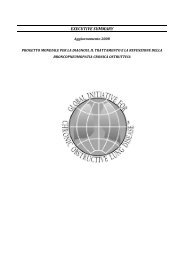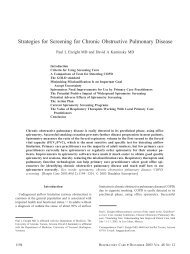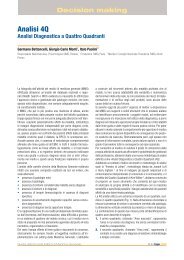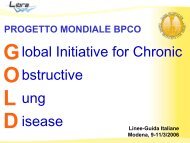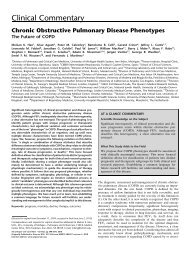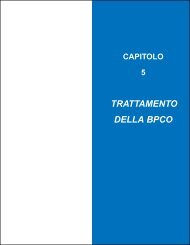Efficacy and safety of NVA237 versus placebo and ... - GOLD
Efficacy and safety of NVA237 versus placebo and ... - GOLD
Efficacy and safety of NVA237 versus placebo and ... - GOLD
You also want an ePaper? Increase the reach of your titles
YUMPU automatically turns print PDFs into web optimized ePapers that Google loves.
E. KERWIN ET AL. COPD<br />
TABLE 2 Spirometry <strong>and</strong> symptom-related (dyspnoea, health status, rescue medication use) outcomes on day 1 <strong>and</strong> weeks 12,<br />
26 <strong>and</strong> 52 (full analysis set population)<br />
Treatment difference<br />
<strong>NVA237</strong>–<strong>placebo</strong> Tiotropium–<strong>placebo</strong> <strong>NVA237</strong>–tiotropium<br />
Day 1<br />
Trough FEV1 L 0.091¡0.0109*** 0.083¡0.0126*** 0.008¡0.0110<br />
FEV1 L (5 min post-dose) 0.087¡0.0081*** 0.045¡0.0093*** 0.041¡0.0081***<br />
FEV1 L (15 min post-dose) 0.143¡0.0089*** 0.078¡0.0102*** 0.065¡0.0089***<br />
Peak FEV1 L 0.200¡0.0126*** 0.152¡0.0146*** 0.047¡0.0126***<br />
FEV1 AUC 0–4 h 0.197¡0.0095*** 0.141¡0.0109*** 0.056¡0.0095***<br />
FEV1 AUC 0–12 h 0.159¡0.019*** 0.127¡0.0214*** 0.032¡0.0189<br />
Week 12<br />
Trough FEV1 L 0.097¡0.0167*** 0.083¡0.0193*** 0.014¡0.0165<br />
Peak FEV1 L 0.176¡0.0178*** 0.142¡0.0204*** 0.033¡0.0173<br />
FEV1 AUC 0–4 h 0.176¡0.017*** 0.147¡0.0194*** 0.03¡0.0165<br />
FEV1 AUC 0–12 h 0.140¡0.299*** 0.107¡0.0337** 0.034¡0.0295<br />
FEV1 AUC 0–24 h 0.106¡0.0283*** 0.079¡0.319* 0.027¡0.0278<br />
FEV1 AUC 12–24 h 0.070¡0.0292* 0.047¡0.0325 0.023¡0.0283<br />
SGRQ total score -3.17¡0.840*** -2.84¡0.967** -0.33¡0.839<br />
TDI focal score 0.60¡0.265* 0.26¡0.303 0.34¡0.257<br />
Week 26<br />
Trough FEV1 L 0.134¡0.0189*** 0.084¡0.0216*** 0.050¡0.0185**<br />
Peak FEV1 L 0.177¡0.0192*** 0.120¡0.022*** 0.057¡0.0189**<br />
FEV1 AUC 0–4 h 0.177¡0.0182*** 0.127¡0.209*** 0.05¡0.0179**<br />
SGRQ total score -3.38¡0.968*** -2.52¡1.113* -0.86¡0.964<br />
TDI focal score 0.81¡0.260** 0.94¡0.297** -0.13¡0.253<br />
Week 52<br />
Trough FEV1 L 0.108¡0.0195*** 0.089¡0.0223*** 0.019¡0.0190<br />
Peak FEV1 L 0.167¡0.0204*** 0.152¡0.0234*** 0.014¡0.02<br />
FEV1 AUC 0–4 h 0.165¡0.0198*** 0.151¡0.0227*** 0.015¡0.0194<br />
FEV1 AUC 0–12 h 0.128¡0.0327*** 0.06¡0.0374 0.068¡0.0328*<br />
FEV1 AUC 0–24 h 0.106¡0.0322*** 0.04¡0.0369 0.066¡0.0322*<br />
FEV1 AUC 12–24 h 0.083¡0.034* 0.021¡0.0389 0.062¡0.0341<br />
SGRQ total score -3.32¡1.004*** -2.84¡1.155* -0.48¡1.002<br />
Change from baseline in mean daily number <strong>of</strong> puffs <strong>of</strong> rescue medication -0.37¡0.181* -0.63¡0.209** 0.25¡0.181<br />
TDI focal score 0.57¡0.276* 0.66¡0.315* -0.08¡0.269<br />
Data are presented as least squares mean¡SE. FEV1: forced expiratory volume in 1 s; AUC: area under the curve; TDI: Transition Dyspnoea Index; SGRQ: St George’s<br />
Respiratory Questionnaire. ***: p,0.001; **: p,0.01; *: p,0.05.<br />
effect <strong>and</strong> sustained 24-h bronchodilation are important features<br />
which may have a significant positive impact on the morning<br />
routines <strong>and</strong> daily life <strong>of</strong> patients with COPD, <strong>and</strong> could<br />
potentially contribute to improving adherence to therapy.<br />
The <strong>GOLD</strong> guidelines recognise the importance <strong>of</strong> symptom<br />
reduction in the management <strong>of</strong> COPD, <strong>and</strong> the assessment <strong>of</strong><br />
symptom severity is a key element in the pharmacological<br />
management <strong>of</strong> COPD [2]. Exertional dyspnoea is one <strong>of</strong> the<br />
most distressing symptoms for patients with COPD [13]. Lung<br />
hyperinflation reduces inspiratory capacity, a measure that<br />
correlates with dyspnoea <strong>and</strong> exercise tolerance in patients<br />
with moderate-to-severe COPD [13]. In the GLOW3 study,<br />
<strong>NVA237</strong> 50 mg produced significant improvements in inspiratory<br />
capacity at isotime (defined as the last matching time<br />
point in submaximal exercise tolerance test at which for both<br />
periods the patient had a test result) at day 1, which was<br />
sustained through the study period <strong>of</strong> 3 weeks (both p,0.001)<br />
[14]. This was accompanied by an immediate <strong>and</strong> significant<br />
improvement in exercise endurance from day 1, which<br />
increased over the study period (both p,0.001). In the current<br />
GLOW2 study, the significantly greater improvement in<br />
inspiratory capacity seen with <strong>NVA237</strong> <strong>versus</strong> <strong>placebo</strong> (comparable<br />
to improvement provided with tiotropium <strong>versus</strong><br />
<strong>placebo</strong>) signifies a greater reduction in hyperinflation, which<br />
may contribute to a reduction in dyspnoea. Furthermore,<br />
<strong>NVA237</strong> produced an improvement in dyspnoea on the TDI<br />
that was superior to <strong>placebo</strong> <strong>and</strong> comparable to tiotropium at<br />
weeks 12, 26 <strong>and</strong> 52. The reduced usage <strong>of</strong> rescue medication<br />
in patients receiving <strong>NVA237</strong> compared with <strong>placebo</strong> also<br />
indicates better symptom management. This overall improvement<br />
was reflected in the SGRQ total scores which were<br />
c<br />
EUROPEAN RESPIRATORY JOURNAL VOLUME 40 NUMBER 5 1111




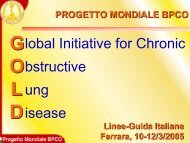
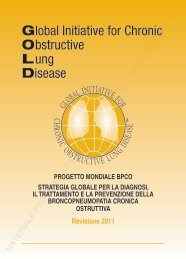
![Di Bari [NO].pdf - GOLD](https://img.yumpu.com/21544924/1/190x143/di-bari-nopdf-gold.jpg?quality=85)

